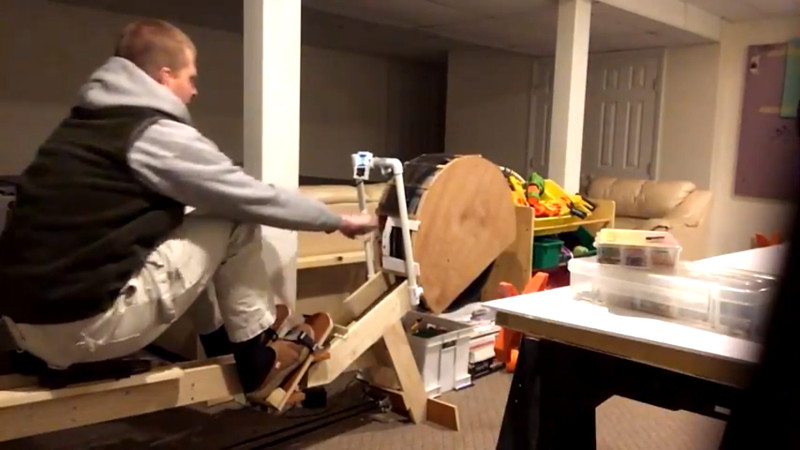An ergometer is a fancy fitness word for a rowing machine, a device which can be used to work out the muscles used in rowing. It’s an excellent cardio workout that can also build upper body strength, and resistance can be varied depending on the individual’s fitness goals. But perhaps you need to measure your workout to see your progress – in which case, [Dave]’s instrumentation package might be right up your alley.
The basic mechanical build involves a wooden frame, fitted with a rowing setup built around a modified bicycle wheel. The wheel has vanes attached, made of what appears to be cut sections of PVC pipe. These act essentially as dampers, using the air to create the resistance for the rower to work against.
The wheel is instrumented with a chopper wheel and an IR optical switch, which measures the rotational speed of the wheel during rowing. This signal is fed into an ATMega328 which runs the calculations on the rower’s performance. It’s all fed to a Nokia 5110 screen for display, which makes a lovely throwback for those that remember the brick fondly.
[Dave] touches not only on the electronic aspects of the build, but also does an excellent job of breaking down the mathematics behind rowing performance. It’s a great resource that builds on top of the excellent work by the OpenErgo project.
If we’ve whet your thirst for exercise machine hacks, you’d better check out this treadmill to belt grinder mod.
















If you’re using an erg to build your upper body you’re doing it wrong. The rowing stroke uses you legs and lower back far more than your arms or upper back.
Basically it’s a power clean or deadlift but horizontal.
Just because the majority of the power comes from your legs and lower back doesn’t mean you aren’t working your upper body. If you aren’t using your arms at all, you may be doing it wrong.
If you’re thinking about rowing like power lifting, you’re not going to get very far. Literally. Even sprints get you waaaay past the anerobic phase. Longer races demand even more endurance, coupled, devilishly, with the ability to put out real power from time to time, while coordinating with everyone else in the boat.
But also, yeah. Arms are secondary to legs. But that also doesn’t mean that they’re not in the game. Rowing is great stuff — I miss it.
Do straw men use rowing machines? Did I miss a scene from The Wizard of Oz?
Wow, that is an awesome level of detail (some actual maths!) despite the photo making it look a bit, er, Heath Robinson.
While having understood the principles of how rowing ergs work (in terms of being able to extrapolate power and drag factors), it’s nice to see the theory behind it and, finally, why I always felt the ‘speed’ value never made sense (because it is just a guess!)
No longer sold so no adv! We made http://www.riverrunner2.com/ with embedded intel board and arduino nano. Now it would be better with a raspberry!!
That’s a very neat trick, getting reasonable estimates of torque and power measurements from only the speed encoder. I would have guessed a strain gauge would be needed.
I always assumed there was a strain gauge is (say) the Concept 2 machine, because one of its displays it shows pulling force vs. time for every stroke.
There doesn’t seem to be an adjustable air intake to vary the load, and I didn’t see it in the writeup. That wouldn’t be too hard to add, I would think. (aside: it’s interesting to note that restricting the airflow on these devices actually *reduces* the load, like a vacuum cleaner behaves.)
The Concept 2 machines use nothing more than a magnetic coil sensing flywheel rotation. Their monitor measures drag during the recovery phase between strokes and uses that to estimate power delivered by the user.
I have been thinking of making a rowing machine in the future for some time now.
But I have though been thinking of having some way of harvesting the energy that is excreted.
Not that it would lead to much power being generated. Since after all, a good hours workout producing an average of 150 watts would only charge around 15-20 smartphones. So not super impressive. (And lets not think about running a microwave oven…)
The best sink for that energy is into a fan pointed at the user’s face.
Expensive electricity. How many pizzas per kilowatt-hour?
Seriously: you gotta question your motives here. If it’s to produce electricity, there are far cheaper AND more environmentally-sound ways to do that. If it’s to lose weight, there’s a much easier way (eat less…). If it’s to get in shape, well, why are you wasting time making a machine to make expensive electricity when you could be getting in shape instead?
If the excuse is “well, I’m producing the power anyway, may as well harvest it”, then you’ll be better off putting that capital expenditure (dollars, time, resources) into less costly ways to move electrons.
I would suggest that you refer to the name of this web site.